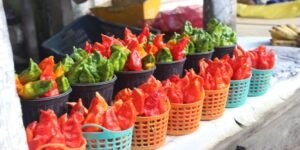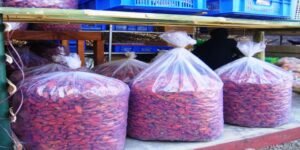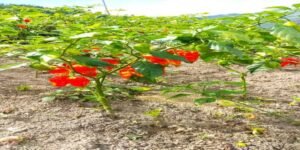
By Imna Longchar
Dimapur (Nagaland), April 21 : Scientifically named as Capsicum Annum or Capsicum Frutescenes, the Naga king chilly, or “bhut Jalokia” has already made its presence felt with its “hotness” garnering a tag as the most hottest chilly in the world with a heat value of 10,01,304 (SHU) using the HPLC analysis by beating the Mexican Red Savana Habaneros (5,77,000 SHU).
The horticulture departments’ joint director, Y. Bongti Konyak, said that the “Naga Mircha”, which is known for its high pungency is found in the districts of Nagaland including the states’ capital,Kohima, followed by Peren, Dimapur, and some parts of Wokha and Mon districts.
Stating that in the recent years, the plantations of the same have been extended to different pockets in the region including Assam, Manipur and also Arunchal Pradesh, for its medicinal values.

Bongti Konyak, also said as per tradition the “Naga Mircha” was used during ancient times to ward of enemies.
However, he said that though there is a huge demand of the “world’s hottest chilly”, Naga Mircha, researchers, and off late, have shown “non interest” which he categorically admitted that the department has been participating in the annual Hornbill Festival by opening its departmental stall and also organizing Naga Chilly eating competition since the inception of the festival.
It is also listed in the “Guinness Book of World Records”, as the “hottest chilly” in the world.

However , Konyak , disclosed that the demand for export to other countries for commercial purpose is still not satisfactory due to small and marginal types of farming in the state.
In this regard, he said that a project has been initiated which aims to encourage the local farmers and other entrepreneurs to take up the challenge by introducing the local farmers to organic farming and cultivation of the chilly in a commercial way.
Also stating that in the present scenario pertaining to the demand of the Raja chilly in Nagaland is very high and even sold according to piece-wise, Bongti disclosed that though there are huge demands from other parts of the country and from international markets of the Chilly the local marginal farmers could not meet the demands.
“The price of the fruit is of no consequences but that the quality and quantity thus need to meet the demand of the people,” said Bongti while also adding that in the recent findings in Kohima alone, a piece of the world’s hottest chilly which costs Rs.5 in the local market are not met by the farmers even during peak seasons (June-September).

Lamenting that till now, no farmer has grown this chilly variety in a large scale as a “profession” for an income generating business, Bongti, however, said that the “world’s hottest chilly” is mainly grown for domestic consumption and the only surplus quantities are sold at the local markets.
He went on to add that the need for self sufficiency and business entrepreneurs competition in the present scenario makes one realize that there is a need to grow Naga Mircha in a commercial manner.
Also mentioning that there is also a “big hurdle” in the cultivation process as this “peculiar” fruit plant is very delicate and “extremely” non-adjustable to many people with regard to handling, the horticulture joint director said that the soil, climate and temperature of the area also plays important role in the cultivation of this plant.
“These are some of the many reasons that the plant is not cultivated by many farmers even though there are huge demands of the fresh and also the dried fruits,” Bongti said.
A proposed project is also in the offing to combine the traditional methods with scientific technologies in regards to the area of cultivation to bring about the change and improve the cultivation of the plant which would encourage the up-coming farmers in the state for agri-business.
Naga Chilly or Raja Mircha, is an indigenous crop of the State which is believed to have originated from the Zelianrong area in Nagaland and is extensively grown in Peren, Mon, Kohima and Dimapur.
It is the first crop from Nagaland to be given the GI tag and one of the hottest known chillies in the world.
Owing to its pungency and also alluring aroma, Naga Mircha or Naga Chilly has always invoked curiosity and awe amongst the people especially, visitors from outside the state.
And in order to give an opportunity to the visitors to have a tete-a-tete up close and personal with the Naga Mircha, Nagaland’s department of Horticulture, has been sponsoring the Naga Chilli eating competition every year coinciding with the annual Hornbill Festival since the year 2010.
According to the joint director, the competition has become a “signature” event of the annual Hornbill Festival which attracts visitors from the country and outside to have a duel with one of the hottest chillies in the world.
It may also be mentioned that Longleng district has the distinction of being the highest producer of the Raja Mircha in the state with a production of 10,2000 metric ton, followed by Peren with 1696 MT and Zunheboto 410 MT.
Nagaland has overall area of 595 hectors land engaged in Raja Mircha cultivation with a total production of 12757.8 MT annually.







































